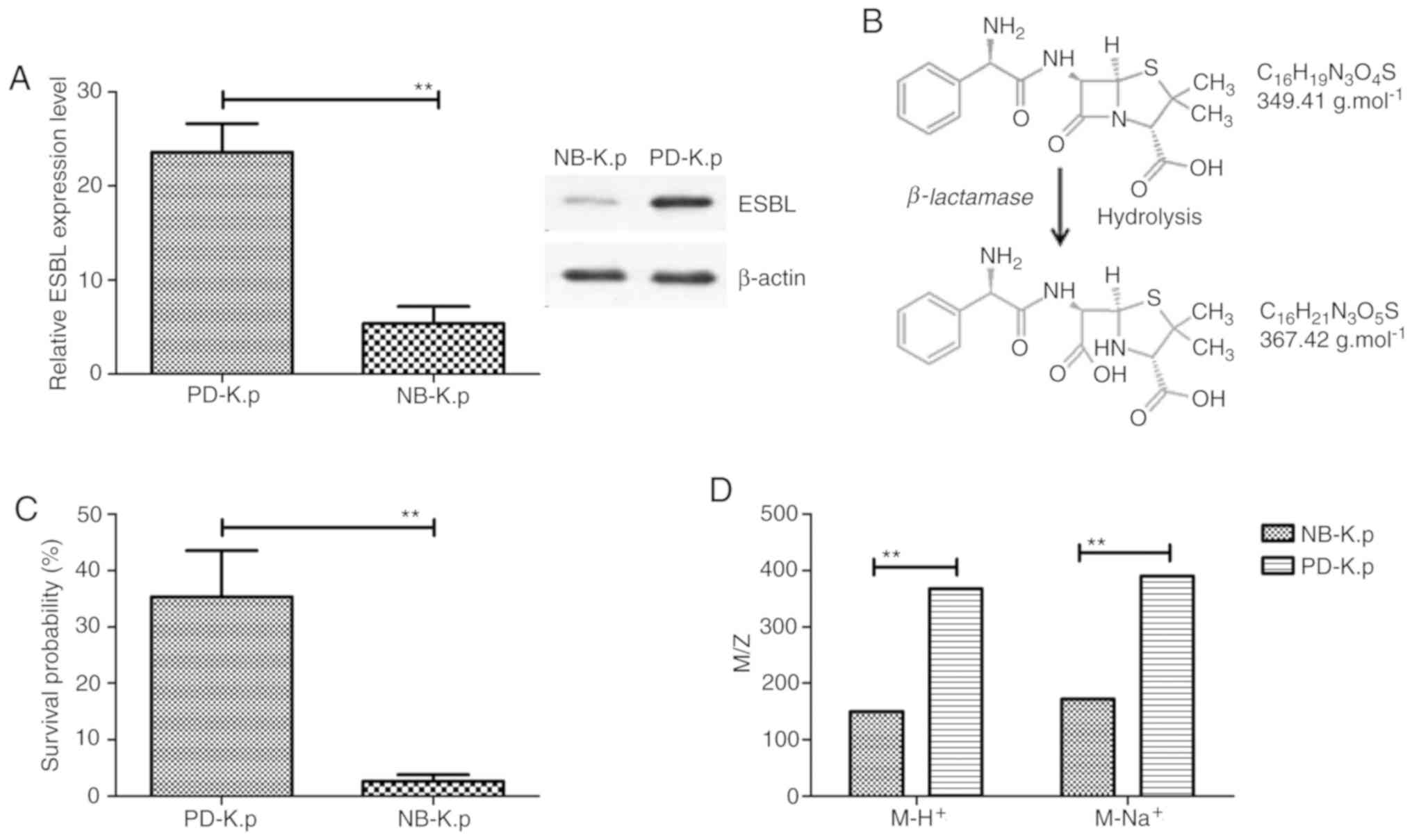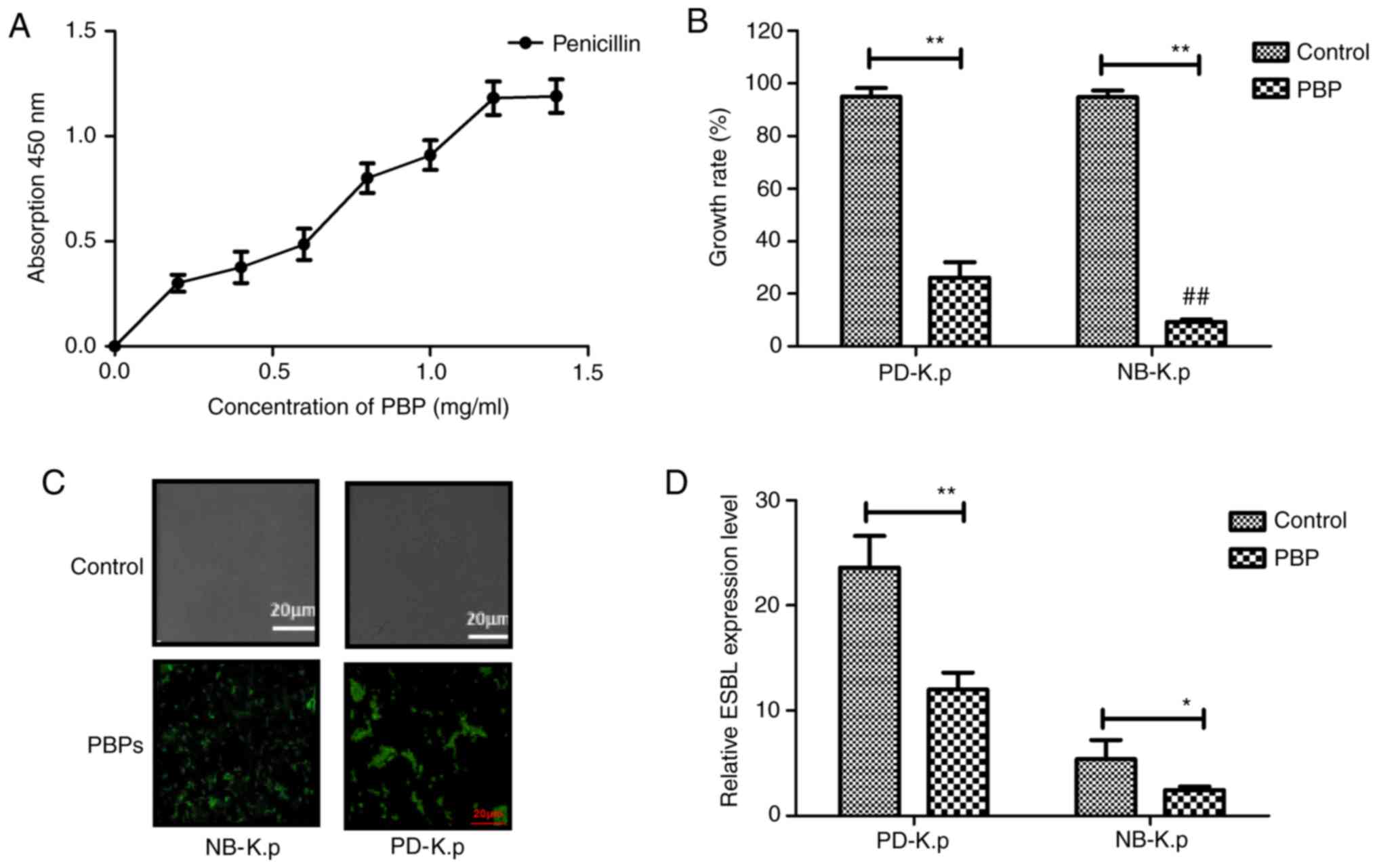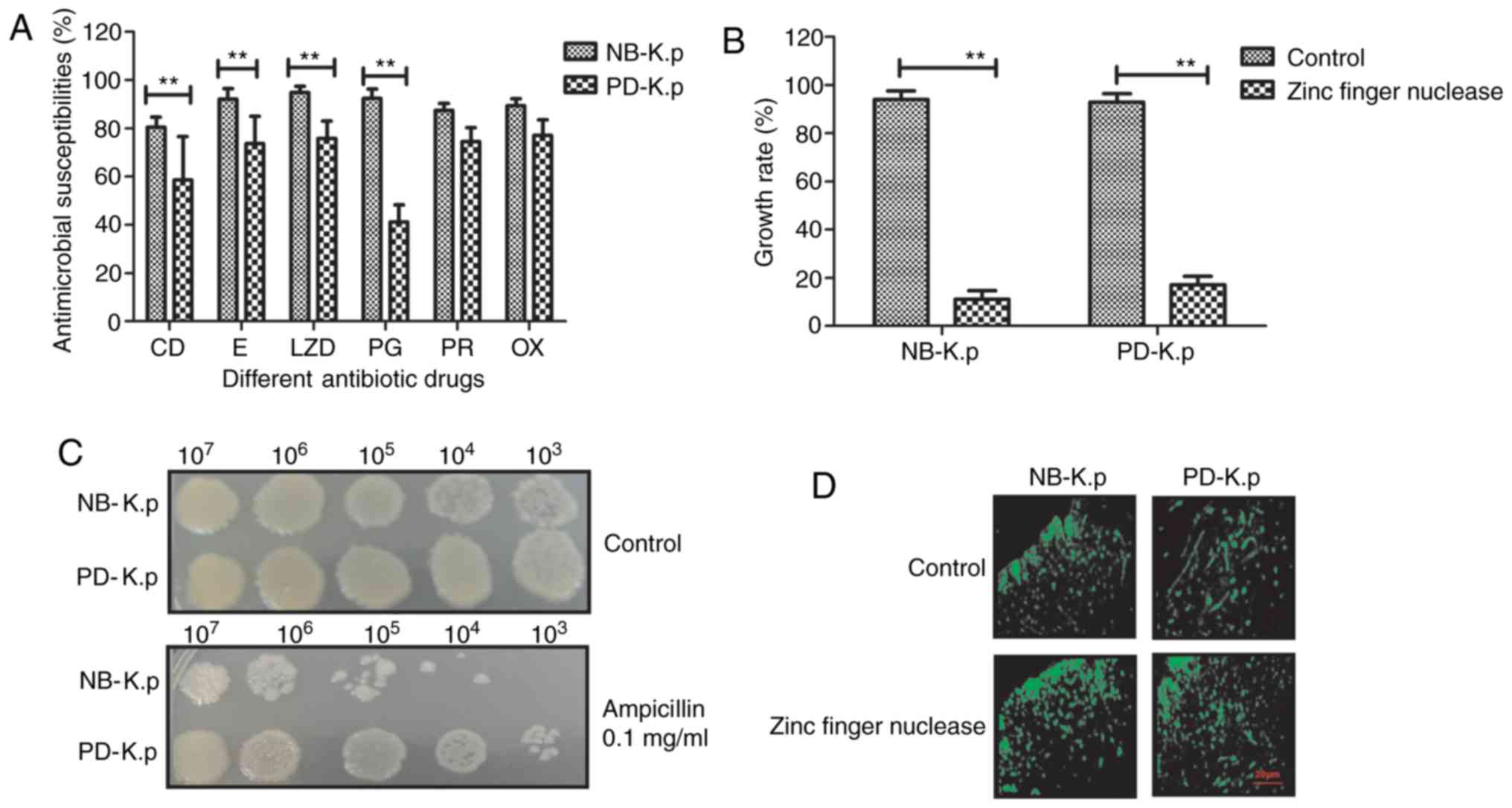|
1
|
Lim MK, Lai PS, Ponnampalavanar SS, Syed
Omar SF, Taib NA, Yusof MY, Italiano CM, Kong DC and Kamarulzaman
A: Antibiotics in surgical wards: Use or misuse? A newly
industrialized country's perspective. J Infect Dev Countries.
9:1264–1271. 2015.PubMed/NCBI View Article : Google Scholar
|
|
2
|
Kardas P, Devine S, Golembesky A and
Roberts C: A systematic review and meta-analysis of misuse of
antibiotic therapies in the community. Int J Antimicrob Agents.
26:106–113. 2005.PubMed/NCBI View Article : Google Scholar
|
|
3
|
Heineman HS and Watt VS: All-inclusive
concurrent antibiotic usage review: A way to reduce misuse without
formal controls. Infect Control. 7:168–171. 1986.PubMed/NCBI View Article : Google Scholar
|
|
4
|
Nõlvak H, Truu M, Kanger K, Tampere M,
Espenberg M, Loit E, Raave H and Truu J: Inorganic and organic
fertilizers impact the abundance and proportion of antibiotic
resistance and integron-integrase genes in agricultural grassland
soil. Sci Total Environ. 562:678–689. 2016.PubMed/NCBI View Article : Google Scholar
|
|
5
|
Stogios PJ, Cox G, Spanogiannopoulos P,
Pillon MC, Waglechner N, Skarina T, Koteva K, Guarné A, Savchenko A
and Wright GD: Rifampin phosphotransferase is an unusual antibiotic
resistance kinase. Nat Commun. 7(11343)2016.PubMed/NCBI View Article : Google Scholar
|
|
6
|
Ferro G, Guarino F, Castiglione S and
Rizzo L: Antibiotic resistance spread potential in urban wastewater
effluents disinfected by UV/H2O2 process. Sci
Total Environ. 560-561:29–35. 2016.PubMed/NCBI View Article : Google Scholar
|
|
7
|
Ouwehand AC, Forssten S, Hibberd AA, Lyra
A and Stahl B: Probiotic approach to prevent antibiotic resistance.
Ann Med. 48:246–255. 2016.PubMed/NCBI View Article : Google Scholar
|
|
8
|
Date KA, Newton AE, Medalla F, Blackstock
A, Richardson L, McCullough A, Mintz ED and Mahon BE: Changing
patterns in enteric fever incidence and increasing antibiotic
resistance of enteric fever isolates in the United States,
2008-2012. Clin Infect Dis. 63:322–329. 2016.PubMed/NCBI View Article : Google Scholar
|
|
9
|
Çöl A, Dedeić-Ljubović A, Salimović-Bešić
I and Hukic M: Antibiotic resistance profiles and genetic
similarities within a new generation of carbapenem-resistant
Acinetobacter calcoaceticus-A. baumannii complex
resistotypes in Bosnia and Herzegovina. Microb Drug Resist.
22:655–661. 2016.PubMed/NCBI View Article : Google Scholar
|
|
10
|
Barger A, Schaade L, Krause G and Kramer
M: Strategies for recognition, prevention and control of
antimicrobial resistances in Germany-a draft from the federal
german ministry of health. Gesundheitswesen. 70:631–635. 2008.(In
German). PubMed/NCBI View Article : Google Scholar
|
|
11
|
Oliva A, Gizzi F, Mascellino MT, Cipolla
A, D'Abramo A, D'Agostino C, Trinchieri V, Russo G, Tierno F,
Iannetta M, et al: Bactericidal and synergistic activity of
double-carbapenem regimen for infections caused by
carbapenemase-producing Klebsiella pneumoniae. Clin
Microbiol Infect. 22:147–153. 2016.PubMed/NCBI View Article : Google Scholar
|
|
12
|
Gajul SV, Mohite ST, Mangalgi SS, Wavare
SM and Kakade SV: Klebsiella pneumoniae in septicemic
neonates with special reference to extended spectrum β-lactamase,
AmpC, metallo β-lactamase production and multiple drug resistance
in tertiary care hospital. J Lab Physicians. 7:32–37.
2015.PubMed/NCBI View Article : Google Scholar
|
|
13
|
Rastogi V, Nirwan PS, Jain S and Kapil A:
Nosocomial outbreak of septicaemia in neonatal intensive care unit
due to extended spectrum β-lactamase producing Klebsiella
pneumoniae showing multiple mechanisms of drug resistance.
Indian J Med Microbiol. 28:380–384. 2010.PubMed/NCBI View Article : Google Scholar
|
|
14
|
Babálová M, Blahová J, Králiková K,
Krcméry V Sr, Menkyna R, Bartoníková N and Skalicková R: Unexpected
reservoir of Klebsiella pneumoniae strains with transferable
multiple drug resistance causing clinical sepsis in newborns. J
Chemother. 17:454–455. 2005.PubMed/NCBI View Article : Google Scholar
|
|
15
|
Sanchez GV, Master RN, Clark RB, Fyyaz M,
Duvvuri P, Ekta G and Bordon J: Klebsiellapneumoniae
antimicrobial drug resistance, United States, 1998-2010. Emerg
Infect Dis. 19:133–136. 2013.PubMed/NCBI View Article : Google Scholar
|
|
16
|
Neupane S, Pant ND, Khatiwada S, Chaudhary
R and Banjara MR: Correlation between biofilm formation and
resistance toward different commonly used antibiotics along with
extended spectrum beta lactamase production in uropathogenic
Escherichia coli isolated from the patients suspected of
urinary tract infections visiting Shree Birendra Hospital, Chhauni,
Kathmandu, Nepal. Antimicrob Resist Infect Control.
5(5)2016.PubMed/NCBI View Article : Google Scholar
|
|
17
|
Chen X, Che J, Zhao XF, Zhang LF and Li J:
Dissemination of insertion sequence common regions 1 and int1 gene
and drug resistance of 483 Escherichia coli and
Klebsiella pneumonia broiler isolates. Zhonghua Yu Fang Yi
Xue Za Zhi. 51:886–889. 2017.(In Chinese). PubMed/NCBI View Article : Google Scholar
|
|
18
|
Sekowska A, Janicka G, Klyszejko C, Wojda
M, Wroblewski M and Szymankiewicz M: Resistance of Klebsiella
pneumoniae strains producing and not producing ESBL
(extended-spectrum beta-lactamase) type enzymes to selected
non-beta-lactam antibiotics. Med Sci Monit. 8:BR100–BR104.
2002.PubMed/NCBI
|
|
19
|
Sanguinetti CM, De Benedetto F and
Miragliotta G: Bacterial agents of lower respiratory tract
infections (LRTIs), beta-lactamase production, and resistance to
antibiotics in elderly people. DEDALO study group. Int J Antimicrob
Agents. 16:467–471. 2000.PubMed/NCBI View Article : Google Scholar
|
|
20
|
Boggio SB and Roveri OA: Catalytic
properties of an endogenous beta-lactamase responsible for the
resistance of Azospirillum lipoferum to beta-lactam antibiotics.
Microbiology. 149:445–450. 2003.PubMed/NCBI View Article : Google Scholar
|
|
21
|
Uraz G, Simsek H and Celik B:
Beta-Lactamase activities and resistance to antibiotics of
Haemophilus influenzae, H. parainfluenzae and H. aphrophilus
strains identified in throat cultures from children. Drug Metabol
Drug Interact. 16:217–228. 2000.PubMed/NCBI View Article : Google Scholar
|
|
22
|
Macheboeuf P, Contreras-Martel C, Job V,
Dideberg O and Dessen A: Penicillin binding proteins: Key players
in bacterial cell cycle and drug resistance processes. FEMS
Microbiol Rev. 30:673–691. 2006.PubMed/NCBI View Article : Google Scholar
|
|
23
|
Shahbazi Dastjerdeh M, Kouhpayeh S,
Sabzehei F, Khanahmad H, Salehi M, Mohammadi Z, Shariati L, Hejazi
Z, Rabiei P and Manian M: Zinc finger nuclease: A new approach to
overcome beta-lactam antibiotic resistance. Jundishapur J
Microbiol. 9(e29384)2016.PubMed/NCBI View Article : Google Scholar
|
|
24
|
Zscheppang K, Kurth I, Wachtel N,
Dubrovska A, Kunz-Schughart LA and Cordes N: Efficacy of beta1
integrin and EGFR targeting in sphere-forming human head and neck
cancer cells. J Cancer. 7:736–745. 2016.PubMed/NCBI View Article : Google Scholar
|
|
25
|
Hsueh PR, Ko WC, Wu JJ, Lu JJ, Wang FD, Wu
HY, Wu TL and Teng LJ: Consensus statement on the adherence to
clinical and laboratory standards institute (CLSI) antimicrobial
susceptibility testing guidelines (CLSI-2010 and CLSI-2010-update)
for enterobacteriaceae in clinical microbiology laboratories in
Taiwan. J Microbiol Immunol Infect. 43:452–455. 2010.PubMed/NCBI View Article : Google Scholar
|
|
26
|
Baruah FK, Hussain AN, Kausalya and
Grover RK: Antibiotic resistance profile of non-fermenting
Gram-negative bacilli isolated from the blood cultures of cancer
patients. J Glob Infect Dis. 7:46–47. 2015.PubMed/NCBI View Article : Google Scholar
|
|
27
|
Hill JT, Tran KD, Barton KL, Labreche MJ
and Sharp SE: Evaluation of the nanosphere Verigene BC-GN assay for
direct identification of gram-negative bacilli and antibiotic
resistance markers from positive blood cultures and potential
impact for more-rapid antibiotic interventions. J Clin Microbiol.
52:3805–3807. 2014.PubMed/NCBI View Article : Google Scholar
|
|
28
|
Ares MA, Alcantar-Curiel MD,
Jimenez-Galicia C, Rios-Sarabia N, Pacheco S and De la Cruz MA:
Antibiotic resistance of gram-negative bacilli isolated from
pediatric patients with nosocomial bloodstream infections in a
mexican tertiary care hospital. Chemotherapy. 59:361–368.
2013.PubMed/NCBI View Article : Google Scholar
|
|
29
|
Patel SJ, O'Toole D and Larson E: A new
metric of antibiotic class resistance in gram-negative bacilli
isolated from hospitalized children. Infect Control Hosp Epidemiol.
33:602–607. 2012.PubMed/NCBI View
Article : Google Scholar
|
|
30
|
Sasirekha B and Shivakumar S: Occurrence
of plasmid-mediated AmpC β-lactamases among Escherichia coli
and Klebsiella pneumoniae clinical isolates in a tertiary
care hospital in Bangalore. Indian J Microbiol. 52:174–179.
2012.PubMed/NCBI View Article : Google Scholar
|
|
31
|
Koczura R, Mokracka J, Krzyminska S and
Kaznowski A: Virulence properties and integron-associated
antibiotic resistance of Klebsiella mobilis strains isolated
from clinical specimens. J Med Microbiol. 60:281–288.
2011.PubMed/NCBI View Article : Google Scholar
|
|
32
|
Lee M, Dhar S, De Benedetti S, Hesek D,
Boggess B, Blázquez B, Mathee K and Mobashery S: Muropeptides in
pseudomonas aeruginosa and their role as elicitors of
β-lactam-antibiotic resistance. Angew Chem Int Ed Engl.
55:6882–6886. 2016.PubMed/NCBI View Article : Google Scholar
|
|
33
|
Lee YD and Park JH: Phage conversion for
β-lactam antibiotic resistance of staphylococcus aureus from foods.
J Microbiol Biotechnol. 26:263–269. 2016.PubMed/NCBI View Article : Google Scholar
|
|
34
|
Shafiq M, Rahman H, Qasim M, Ayub N,
Hussain S, Khan J and Naeem M: Prevalence of plasmid-mediated AmpC
β-lactamases in Escherichia coli and Klebsiella
pneumonia at tertiary care hospital of Islamabad, Pakistan. Eur
J Microbiol Immunol (Bp). 3:267–271. 2013.PubMed/NCBI View Article : Google Scholar
|
|
35
|
Goessens WH, Mouton JW, Ten Kate MT,
Sorgel F, Kinzig M and Bakker-Woudenberg IA: The therapeutic effect
of tigecycline, unlike that of Ceftazidime, is not influenced by
whether the Klebsiella pneumoniae strain produces
extended-spectrum beta-lactamases in experimental pneumonia in
rats. Antimicrob Agents Chemother. 57:643–646. 2013.PubMed/NCBI View Article : Google Scholar
|
|
36
|
Rivera A, Larrosa N, Mirelis B and Navarro
F: Importance of quality control for the detection of β-lactam
antibiotic resistance in enterobacteriaceae. Enferm Infecc
Microbiol Clin. 32 (Suppl 1):S30–S36. 2014.(In Spanish). PubMed/NCBI View Article : Google Scholar
|
|
37
|
Padilla E, Alonso D, Domenech-Sanchez A,
Gomez C, Pérez JL, Albertí S and Borrell N: Effect of porins and
plasmid-mediated AmpC beta-lactamases on the efficacy of
beta-lactams in rat pneumonia caused by Klebsiella
pneumoniae. Antimicrob Agents Chemother. 50:2258–2260.
2006.PubMed/NCBI View Article : Google Scholar
|
|
38
|
Wragg R, Harris A, Patel M, Robb A,
Chandran H and McCarthy L: Extended spectrum beta lactamase (ESBL)
producing bacteria urinary tract infections and complex pediatric
urology. J Pediatr Surg. 52:286–288. 2017.PubMed/NCBI View Article : Google Scholar
|
|
39
|
Charrouf FO, Hamze M, Mallat H, Achkar M
and Dabboussia F: Characterization of resistance genes in 68
ESBL-producing Klebsiella pneumonia in Lebanon. Med Mal
Infect. 44:535–538. 2014.PubMed/NCBI View Article : Google Scholar
|
|
40
|
Ogawara H: Self-resistance in
streptomyces, with special reference to beta-lactam antibiotics.
Molecules. 21(E605)2016.PubMed/NCBI View Article : Google Scholar
|
|
41
|
Navarro Jimenez C, Luque Marquez R, de
Torres Solis I and Aguilar Guisado M: Changes in empiric therapy
for nosocomial pneumonia due to the emergence of bacterial strains
with broad spectrum beta-lactamases. Med Clin (Barc).
122(679)2004.(In Spanish). PubMed/NCBI View Article : Google Scholar
|


















